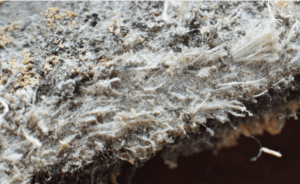Mesothelioma Causes
The only known cause of malignant mesothelioma is exposure to asbestos, a carcinogenic mineral that was used heavily by many industries for decades. Asbestos fibers, when inhaled or ingested, remain in the body and cause irritation that mutates healthy cells into cancerous ones.
What Causes Mesothelioma?

Asbestos exposure causes mesothelioma. Asbestos is a fiber-like material that was used in building and car parts between the 1930s and early 1980s.
If asbestos-based products were handled or disturbed, they released fibers into the air. Anyone nearby could inhale the fibers, which can get stuck in the body, damage healthy tissue, and eventually cause mesothelioma.
Even though manufacturers knew that asbestos caused life-threatening illnesses like mesothelioma, they continued to profit off of asbestos-containing products while millions of innocent people were put at risk.
Asbestos has a long latency period, meaning it takes 10-50 years before symptoms of mesothelioma begin to appear after exposure.
Many people may feel blindsided after being diagnosed with mesothelioma trying to remember when they were first exposed to the harmful mineral. Our team at the Mesothelioma Resource Group can help you and your family through this difficult time.
We can match you with a mesothelioma specialist closest to you, and also see if you are eligible for mesothelioma compensation. Download our Free Mesothelioma Guide today or contact us at (888) 360-2406 to get started.
 Free 2023 Mesothelioma Guide
Free 2023 Mesothelioma Guide- Find Cancer Resources
- Get Medical Care
- Access Compensation


How Asbestos Exposure Causes Mesothelioma
Here’s a breakdown of how asbestos exposure leads to mesothelioma:
1. Initial Asbestos Exposure
When asbestos-containing products are disturbed, such as removing asbestos insulation, they may release asbestos dust into the air.
2. Inhaling or Swallowing Asbestos Fibers
After the fibers are released into the air, people can inhale or swallow the asbestos fibers. Once in the body, the fibers will settle in the pleura (the lining of the lungs), the peritoneum (the abdomen lining), the pericardium (the heart lining), or the tunica vaginalis (the pouch that covers the testicles).
3. Damage to Healthy Cells
Over time, the fibers will inflame and scar healthy mesothelial cells. Unfortunately, the human body cannot remove or break down asbestos fibers because they are so small and strong.
4. Mesothelioma Growth
After 10-50 years of causing inflammation and scarring, asbestos fibers will damage the DNA of healthy cells, leading to the rapid growth and spread of mesothelioma cancer cells. The cancer cells can form tumors that quickly spread through the body without treatment.
Causes of Mesothelioma by Type
There are four main types of mesothelioma. All types are caused by asbestos exposure. Which type you may develop depends on where asbestos fibers end up in your body.
Pleural Mesothelioma Causes
Asbestos exposure most commonly causes pleural mesothelioma. More than 8 in 10 cases of mesothelioma fall under this type.
Malignant pleural mesothelioma may develop if someone inhales asbestos fibers. The fibers can settle in the lining of the lungs and cause irritation.
As time goes on, the fibers cause scarring and eventually change healthy cells into cancerous ones. After 10-50 years, symptoms of pleural mesothelioma (chest pain, trouble breathing, and a cough) may begin to develop.
Unfortunately, the cancer is usually in an advanced stage by the time symptoms appear.
Peritoneal Mesothelioma Causes
Peritoneal mesothelioma is the second most common type of this cancer. It’s caused when asbestos fibers are swallowed and get lodged in the abdominal lining.
As the irritation and inflammation caused by the fibers continue, cancerous cells may begin to grow. Symptoms of peritoneal mesothelioma include appetite changes, bloating, and severe weight loss.
Causes of Rare Mesothelioma Types
In extremely rare cases, people could develop pericardial mesothelioma or testicular mesothelioma after asbestos exposure.
Less than 500 cases have been reported for each type, but doctors can still recommend treatments for either. Testicular mesothelioma is much easier to treat than pericardial mesothelioma.
How Much Asbestos Exposure Causes Mesothelioma?
There is no safe level of asbestos exposure. Even one instance of asbestos exposure can cause mesothelioma later in life.
This is because the body cannot break down or remove the microscopic fibers, which cause irreversible damage over time.
However, people who are routinely exposed to asbestos in high amounts (such as at their jobs) are at the highest risk of getting sick.
Those who are exposed to asbestos frequently are more likely to have large concentrations of asbestos fibers in their bodies. This increases the damage, inflammation, and risks of mesothelioma.
 Free 2023 Mesothelioma Guide
Free 2023 Mesothelioma Guide- Find Cancer Resources
- Get Medical Care
- Access Compensation


Mesothelioma Risk Factors
Some people may be at increased risk of mesothelioma than others due to several factors. These factors are not necessarily causes of mesothelioma. Instead, they may put individuals at higher risk of exposure to asbestos and thus to develop mesothelioma.
Common risk factors for mesothelioma include:
- Having a family history of cancer: Some families are at a higher risk of mesothelioma due to their genetics. For example, some people are born with a mutated BAP1 gene, which makes them more likely to develop mesothelioma if they’re exposed to asbestos.
- Living with someone who worked with asbestos: People who lived with someone who used asbestos-based products at their job are more likely to develop mesothelioma. This is because asbestos fibers and particles can travel home on the worker’s clothing and skin and become airborne in the home.
- Serving in the United States Armed Forces: U.S. veterans are at high risk of developing mesothelioma because asbestos was used heavily by every branch of the military until the early 1980s.
- Working in jobs that exposed you to asbestos: Asbestos was used in dozens of industries (including construction work, shipbuilding, and plumbing) from the 1930s through the early 1980s. People with high rates of asbestos exposure, such as shipyard and construction workers, are more likely to develop mesothelioma.
How Are People Exposed to Asbestos?
Asbestos exposure can happen anywhere that asbestos-containing products are used. However, there are some places where these products are more likely to be in use than others.
Asbestos in the Workplace
For decades, many people working in blue-collar jobs or trade jobs handled asbestos-containing products every day.
Over 27 million workers were exposed to asbestos between 1940 and 1979, according to the Agency for Toxic Substances and Disease Registry (ATSDR).
Workplaces with a higher risk of asbestos exposure include:
- Automobile assembly factories
- Chemical plants
- Coal mines
- Construction sites
- Mining sites
- Power plants
- Shipyards
- Steel mills
Although the use of asbestos has decreased since the 1980s, these occupations still come with a risk of asbestos exposure today, especially if employees are working at older buildings or renovation sites.
Asbestos in the Military
The U.S. military used asbestos to make its ships, bases, and vehicles durable and flame-resistant. As a result, many U.S. veterans developed mesothelioma.
1 out of every 3 mesothelioma patients is a U.S. veteran due to widespread military asbestos use.
The U.S. military frequently used asbestos in:
- Aircraft
- Bases and other buildings
- Ships
- Vehicles
Navy veterans have a higher risk of developing mesothelioma than veterans of the other branches, as asbestos was used on almost all Naval ships until the dangers were well-known.
Asbestos in Everyday Environments
People can also encounter asbestos in everyday environments. For example, older homes often contain asbestos-based products like shingles, floor tiles, and insulation.
You may also find asbestos in:
- Automobile brake pads and linings, gaskets, and clutch facings
- Boilers
- Cement sheets around wood-burning stoves and furnaces
- Furnace ducts
- Soundproofing material sprayed on ceilings and walls
- Steam pipes
Preventing Asbestos Exposure and Mesothelioma
Despite asbestos use being heavily restricted since the early 1980s, millions of people may still be at risk of mesothelioma today. This is because it takes decades for mesothelioma to develop after asbestos exposure.
There’s no way to fully prevent mesothelioma if you’ve already been exposed to asbestos. That said, there are still some actions you can take to help safeguard yourself and others.
To reduce the risks, you can:
- Become an advocate for asbestos bans: Asbestos is still not completely banned in the United States. You can limit continued asbestos exposure in your community by becoming an advocate for asbestos bans.
- Follow asbestos safety regulations: If you work with asbestos, follow all safety regulations to minimize exposure. Your workplace should provide you with personal protective equipment to keep you safe. Regularly changing clothes and showering can also help protect you from secondhand exposure.
- Get inspections for older homes and buildings: If your home was built between the 1930 and the early 1980s, it may contain asbestos products. Getting a home inspection will help determine whether the asbestos in your home is a threat and if it can be removed.
- Have a professional remove asbestos: Hire a professional to remove any asbestos in your home if needed. Do not handle asbestos on your own.
- Know the risks of asbestos: Identify places with a high concentration of asbestos and try to avoid them.
- Receive regular tests for asbestos diseases: If you’ve been exposed to asbestos in the past, ask your doctor about getting tested or screened for asbestos-related diseases. This is especially important if you may be suffering from possible symptoms of mesothelioma.
 Free 2023 Mesothelioma Guide
Free 2023 Mesothelioma Guide- Find Cancer Resources
- Get Medical Care
- Access Compensation


Find Out More About Mesothelioma Causes & Resources
Mesothelioma is an incredibly aggressive cancer, and many feel confused and overwhelmed before and after a diagnosis. It may also be hard to pinpoint when, where, and how you were exposed to asbestos.
You do not have to go through this alone. The team at Mesothelioma Resource Group is here to help.
We can help you:
- Determine when, where, and how you may have been exposed to asbestos
- Find medical care from top mesothelioma doctors faster
- Pursue financial aid on your behalf for medical expenses
- Secure justice from the companies that harmed you
Call (888) 360-2406 or fill out our online form for a free mesothelioma case review.
Mesothelioma Causes FAQs
How much asbestos exposure causes mesothelioma?
Any level of asbestos exposure is dangerous. Even trace exposures can lead to mesothelioma.
However, people who are exposed to asbestos in high amounts and for years or decades are at the highest risk of developing mesothelioma.
Can mesothelioma be caused by smoking?
No, smoking is known to cause mesothelioma. However, smoking may increase the chances of developing the cancer even with minimal asbestos exposure.
This is because tobacco smoke can increase inflammation and irritation already present from asbestos fibers. As irritation continues, cells begin turning into malignant mesothelioma cells.
Those who smoked and were exposed to asbestos are at a very high risk of asbestos lung cancer.
Are there different mesothelioma causes for different types of mesothelioma?
No, asbestos exposure is the primary cause of each type of mesothelioma.
If asbestos fibers are inhaled, it could be more likely to develop into pleural mesothelioma, which affects the lining of the lungs.
In contrast, if the asbestos fibers are swallowed someone could develop peritoneal mesothelioma, which affects the lining of the stomach.
However, because the fibers are so small, it is possible that any type of exposure can cause the fibers to travel throughout the body and cause various types of mesothelioma.
Is mesothelioma curable?
Unfortunately, there is no official cure for mesothelioma at this time. However, it is possible for mesothelioma patients to achieve long-term survival. Some patients have lived for several years or even decades.
Getting an early diagnosis and cancer treatments may increase your chances of receiving effective treatment options and improving your life expectancy.
What are mesothelioma causes other than asbestos?
Asbestos is still considered the only known cause of mesothelioma.
However, researchers are looking into other possible mesothelioma causes.
A family history of gene mutations, as well as exposure to radiation and zeolites (other minerals that can cause cancer), may possibly increase the risks of mesothelioma. More research is needed to confirm these risks.
